Le Pho, The Virgin Mary and the Child Jesus, circa 1938, or an european construction
In 1970, art critic Waldemar–George (1893-1970) published his eponymous book with the evocative title: ”Le Pho, the divine painter”. In his book, the author lists the European locations visited by Le Pho during his first trip to the West in 1931-32, as well as a list of all the painters that meant something to him.
He mentions a “prolonged stay” in Italy, particularly Fiesole, (located in the vicinity of Florence), the city of Florence itself and its museums, but also Bruges (Belgium) and Cologne (Germany).
He also names the painters who “captured” Le Pho such as Jean Fouquet, the “Master of Moulins“, Sandro Botticelli, Domenico Ghirlandaio, Hans Memling, Stefan Lochner.
Four cities, six painters, all European, that will significantly influence Le Pho.
Among many other black and whites, one full-page colour painting stands out early in the book. The painting is titled ”Fiesole” (1931) and it seems to set up the foundation on which is built Le Pho’s entire work.
This precise list of places and painters is even more precious as Waldemar-George’s book was published (with hardly any means) by Le Pho himself. The family has helped out: The artist’s son Pierre Le Tan for the layout, his brother-in-law Marc Vaux and his other son Alain Le Kim for the photographs. And if Paulette, the discreet but attentive wife, is not mentioned in the credits, her influence can’t be understated.
The artists : Jean Fouquet (circa 1420 – around 1480) was likely born in Tours where he died; the “Master of Moulins” (identified later as the painter Jean Hey), born in Flanders around 1455, died in Paris around 1555 and executed his famous triptych in 1502 ; Sandro Botticelli (1444-1510), born and died in Florence; Domenico Ghirlandaio (1449-1494) born and died in Florence; Hans Memling (1435-1495) born in Germany but raised in Bruges. … without forgetting Stefan Lochner (1410-1451), born in Meersburg and died in Cologne.
Italy of the Renaissance in the 15th century is mostly represented but also more largely Europe with a Frenchman (influenced by the Flemish Renaissance), a Flemish, two Italians, a German from Bruges (future Belgium), a German from Cologne.
At the time in Europe sensibility was considered more important than nationalities, art was a passport.
Let’s not lose ourselves trying to label all these talents as “Primitive“, “International Gothic“, “post” or “pre-Renaissance”. On the contrary, let’s emphasize that in the 15th century, exchanges between artists only get stronger and intense: Jean Fouquet went to Italy around 1455 not long after Rogier van der Weyden (c. 1400-1464), who in 1450 went to Rome for the Jubilee.
Four key motivations explain why journeys seems to be more from the North to the South than from the South to the North:
- Religion: these are pilgrimages and/or the granting of indulgences.
- The study of Antiquity (a tradition inaugurated by Albrecht Durer in 1494).
- Diplomacy: Jan van Eyck was sent to Portugal by Philippe le Bon.
- The desire to become a court painter (and there were many courts…)
Heading North, among others, were Zanetto Bugatto (1440-1476) and Benedetto (1458-1497, Domenico’s younger brother) Ghirlandaio comes to France probably on the invitation of Gilbert de Bourbon-Montpensier.
Mobility of painters and works.
The collections in the making are stronger agents of influence. The confrontation wasn’t about talents from diverse origins, but an exchange – not of ideas, but of worlds: a kind of civilizational deflagration, that Le Pho will experience one half-millennium later.
Right in the center of this upheaval is the Italian Renaissance, one of the most prosperous periods of Humanity that will not accept resigned men. The ancient Greek and Roman texts were not discovered there but they were carefully preserved with care and use to further and better translated and analyzed. The questioning stimulates reflection. Ancient ruins, once better understood, bear witness to the power of the past. However, texts and monuments were mostly prior to the revelation of Christ.
To value the profane knowledge when it comes to religion: such is the intention of all actors in these times.
Petrarch (1304-1374) in Florence – the city that fascinated Le Pho – explains that the man, if he is exceptional, must take center stage. Protagoras (5th century B.C.) is the chosen spiritual guide when he asserts via Plato:
« Of the gods I know neither if they are or are not »
and that
« Man is the measure of all things. »
But in the spirit of the Renaissance this man must be a scholar.
And Marsilio Ficino (1433-1499) wants knowledge to be a contemplation of the idea of beauty: to contemplate the profane’s beauty allows the soul to reach sacred Beauty. Ficino reconciles Plato and the Bible.
The supreme talent that Le Pho discovers precisely represents what he was seeking, in Vietnam, since he reached the age of reason: the pre-eminence of the man over his environment and the cultural exchange as the drivers of progress in the world.
The high Mandarin’s son, immersed from a young age – like all Vietnamese – in the cult of the ancestors, Buddhist by influence, Confucian by tradition, wanted to develop his own identity in those years 1931-32.
His painting was inspired by:
- The Master of Moulins, from whom he borrowed the Virgin and the child Jesus’ faces gazing in the same direction.
- Jean Fouquet, the veil, the ovoid face of the Virgin, in an icy tone.
- Sandro Botticelli, the multiform symbolism (here the pomegranate, the rose), the child’s chubbiness, the care given to the clothes. Perhaps even an attempt to achieve a certain light through the use of gouache and ink.
- A bit of all of that from Domenico Ghirlandaio with, in addition, the halos and the contemporary decor of the work creating uchronia.
- A lot of all that from Hans Memling with also their illustration of strength of the oil painting… and the conquering suavity of Stefan Lochner.
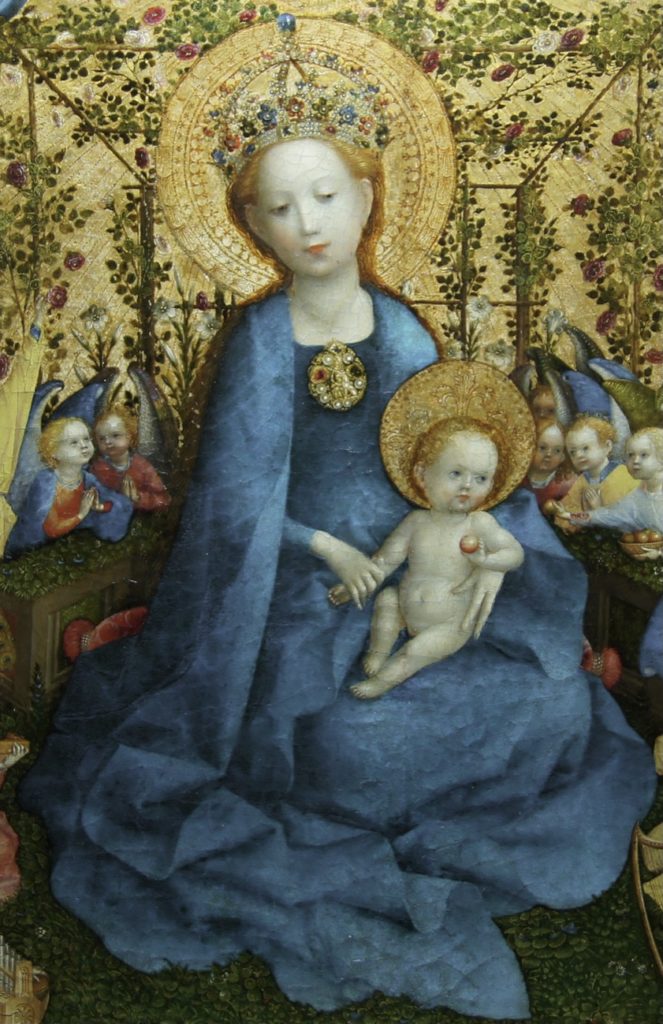
Stefan Lochner – circa 1440-1442 (extract) 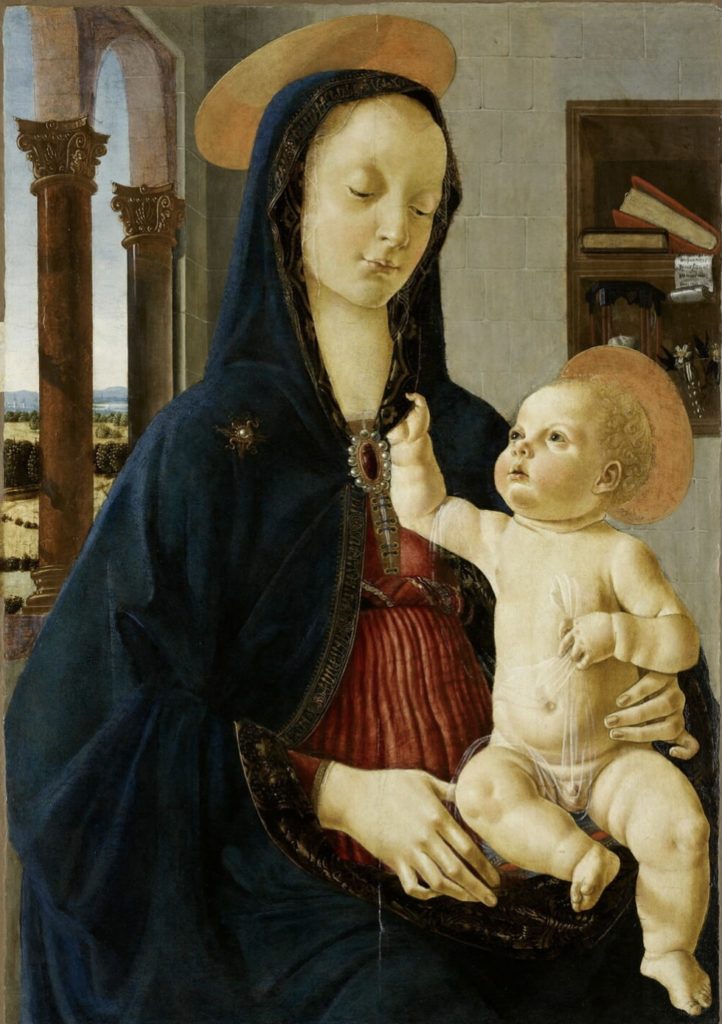
Domenico Ghirlandaio – circa 1450-1500 (extract) 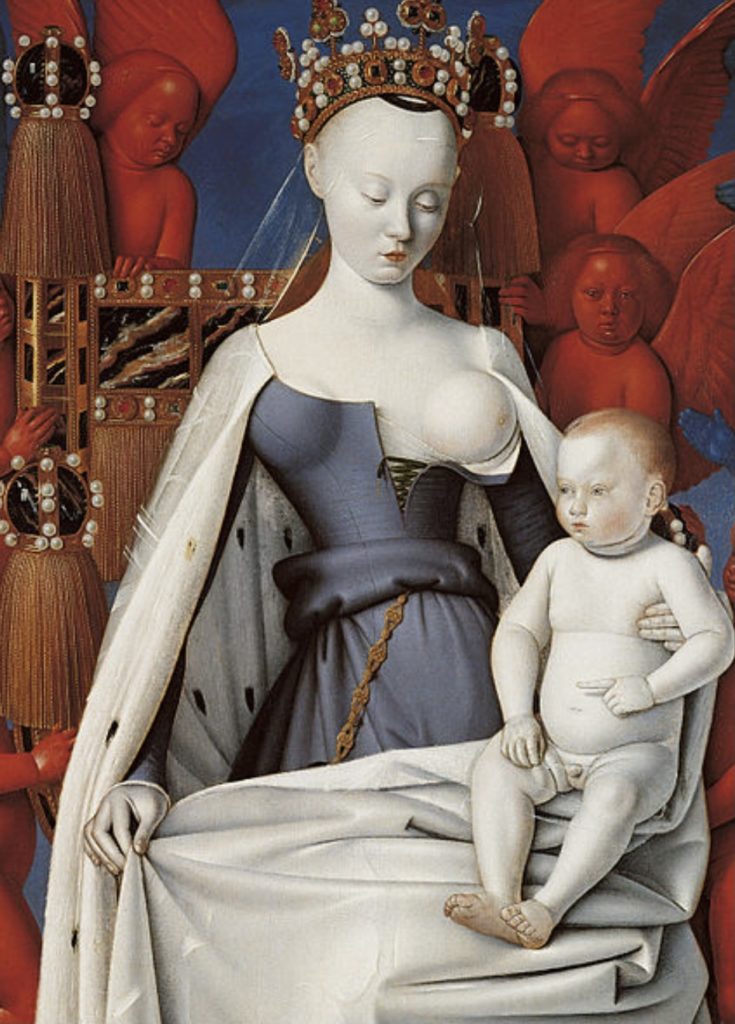
Jean Fouquet – circa 1452-1458 (extract) 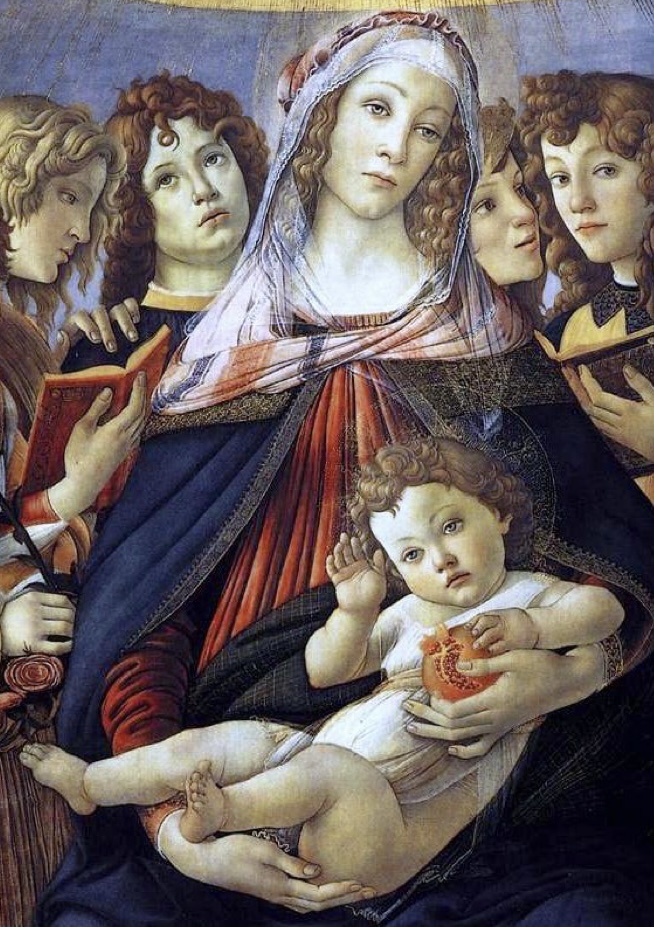
Sandro Botticelli – 1481 (extract) 
Hans Memling – 1487 (extract) 
Maître de Moulins (Jean Hey) – circa 1498-1499 (extract)
Clearly, Le Pho could not have missed seeing these paintings during his travels. These paintings are still on display in the same places as during Le Pho’s travels: the triptych in Moulins, the Fouquet in Antwerp (in the Royal Museum of Fine Arts), the Botticelli in Florence (in the Uffizi Museum), the Ghirlandaio in Paris (in the Louvre), the Memling in Bruges (in the Memling Museum in the Saint John Hospital), the Lochner in Cologne (in the Wallraff-Richartz Museum).
Le Pho, six-seven years after his journey – most certainly enriched by other visits and much reflection – present us with his own Madonna and Child:
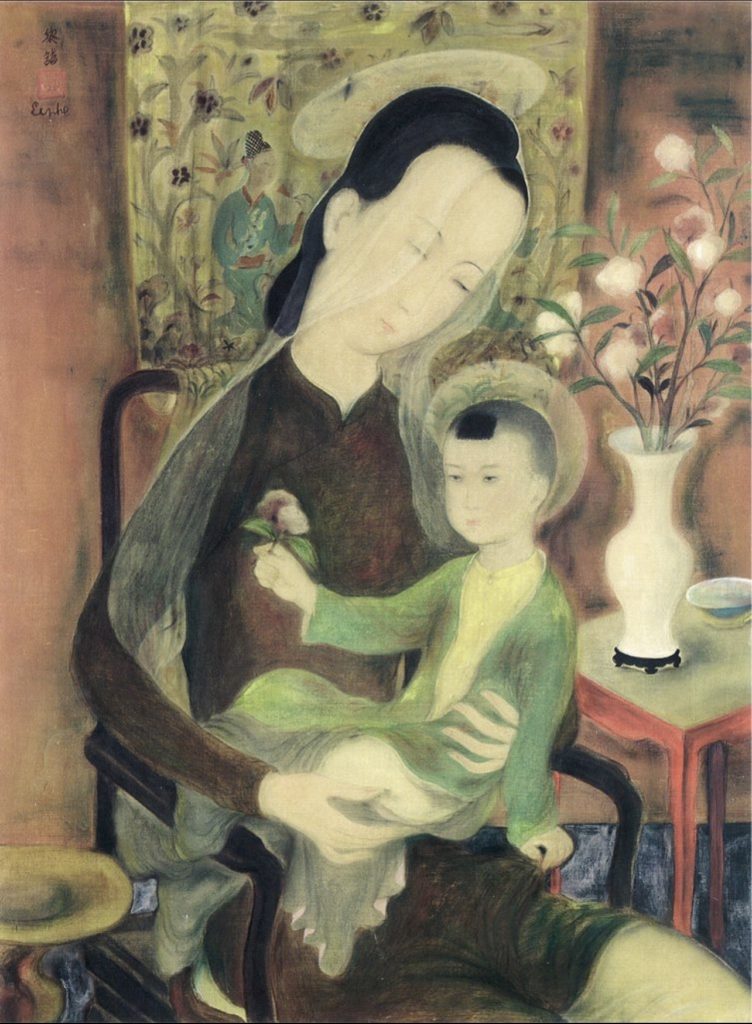
Discreet (transparent) halos over both subjects’ head testify – here – of their Christian divinity. A Christianity with clear Asian features, shown by their faces, the mother’s slightly faded compared to the child’s. The faces are not very expressive, in a way Giotto (1267-1337) would not have accepted. The two gazes, with the child looking far away, and the Virgin is attentive to her son, depicting a tender, earthly mother and a meditative, almost celestial child.
The Virgin’s hands, of exaggerated size, express two different gestures: the left, with an almost claw-like grip, embraces the child, while the right supports him gently: strength and gentleness, ideal attributes of parental love.
The child does not offer the two roses to his mother, he seems to be holding them up. The rose symbolizes the incarnation of God in Jesus but also the denomination of the Virgin in the Catholic tradition. Hence the “two” roses? The Virgin Mary is dressed in the ao dai of the contemporary style renewed in Hanoi in the 1930s by Lemur and Le Pho. She also embraces the child with her mantilla.
All the furnishings point to a Tonkinese Mandarin’s interior: the armchair in a natural hardwood and the orange lacquered wooden table are characteristic of the 1930s. On the table a Chinese vase – a 18th century style. It is filled with white pomegranate flowers (the pomegranate, symbol of Jesus for Catholics…) cut and not in a pot as often in the painter’s previous works, and is next to a cup.
On the bottom left is a vase, in the shape of a mushroom, that, seems to imposes itself as if the decor didn’t want it there again Chinese: The “lingzi” (in Chinese) is the divine mushroom, a Taoist symbol of both prosperity and longevity. It resonates with the wall hanging representing a Taoist scholar, identifiable by his cap, while the flowers around him can’t be identified.
Le Pho keeps us updated – up to date ? – with his fascinations of the moment: the powerful intellectual, moral, mental shock of his return to Paris a year earlier. It is not complement, it is just more soul. Mary and Jesus can be Vietnamese but – all artist are prophets – imagining the exegesis to come, Le Pho refuses to consider a backward exoticism: for an artist, the strangeness and the distance are not taken into consideration. The stakes are high and Le Pho claims himself not to be a heir but rather like a contemporary incarnator of Renaissance’s humanism which “has something heroic and euphoric (which) attributes to the man a power to be, to understand and to act, no equivalent will be found thereafter” (Abdennour Bidar “History of humanism in Occident” (2021. p 203)) Who “…invents the man capable of everything” (ibid p 204).
Because in 1938, Le Pho wants to be capable of everything.
Through this painting, inspired by the masters he so much admires, he claims identity versus ethnicity, culture versus race, eternity versus the temporal, the individual versus the group.
Further more: personality versus individuality.
The names of his great ancestors, from hereon in, will no longer be inscribed in Chinese characters on the altar of his ancestors in Hadong, Vietnam, and will be replaced by those of the masters of the Renaissance.
But if reference is be reverence, it is not submission. Soon thereafter, Le Pho, on an intellectual level, will be drawn closer to Matisse and Bonnard and his Romanet and Findlay’s periods will show new ambitions.
But this is another story.
Jean-François Hubert